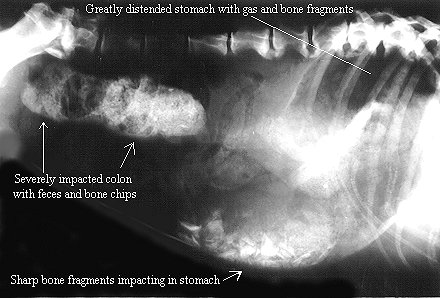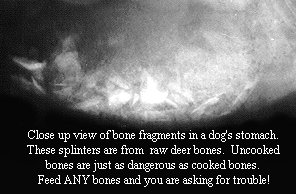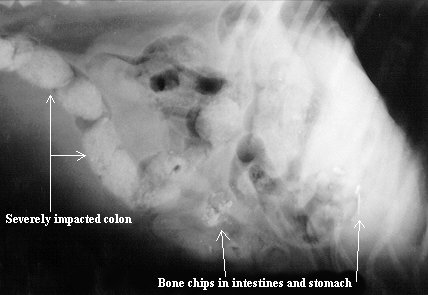Can Dogs Eat Bones? Raw & Cooked Bones for Dogs
By T. J. Dunn Jr., DVM
You've probably heard people say that feeding bones is natural and healthy for dogs (for a report on the nutritional value of bones, read this) and that feeding bones promotes clean teeth and aids the nutritional status of the animal. But “natural” does not always equate with “healthy.” For example, wild mushrooms are certainly natural, but certain types will kill a dog if eaten. Let’s investigate the pros and cons of feeding bones to help you determine if and what types of bones might be appropriate for your dog.
Are Bones Safe for Dogs?
After enjoying a nice dinner and noticing your dog eyeing the bones that were left behind, many people wonder, "Can dogs eat bones?" As is often the case, the answer depends on the details.
Cooked bones should always be off-limits. They become brittle and easily break into sharp shards that can do a lot of damage when they pass through the gastrointestinal tract. Never feed your dog cooked bones. This includes those that originate in your kitchen and those that can be purchased. The U.S. Food and Drug Administration (FDA) reports that between Nov. 1, 2010 and Sept. 12, 2017, it received accounts of 90 dogs who became sick after eating commercially-available smoked or baked bone treats. Fifteen of the dogs died.
Raw bones are generally safer than cooked, but again, the devil is in the details. If you want to give your dog a bone because chewing provides mental stimulation and can help keep the teeth clean, Dr. Karen Becker recommends picking a raw bone that is approximately the size of your dog’s head. Bones of this size will allow your dog to gnaw while helping to reduce the chances that your dog will break off and swallow a chunk of bone that can cause health problems.
But Dr. Becker still recommends that dogs should always be monitored when they are chewing on bones. Why? Unchecked access to bones, even raw bones, can have disastrous results. Here are just a few examples where a dog has been very seriously harmed by ingesting raw bones.
Below are X-rays of a case presented to Dr. Ray Goodroad. This hound of about 75 pounds was found by his owner feeding on a dead deer carcass. The dog became very lethargic, attempted unsuccessfully to vomit and pass stool, and was dehydrated. Sharp bone fragments are clearly visible.
 |  |
Now take a look at these two X-rays. They are of a dog that was straining to pass stool and was weak and dehydrated when presented to the veterinarian. The dog, Dr. Goodroad would learn, had a history of raiding the neighbor's garbage cans.
 |  |
Both of these dogs required four days in the hospital, anesthesia and sedation, repeated enemas, intravenous fluid, therapy, antibiotics, and additional X-rays. If this treatment approach wasn't successful, major surgery would have been necessary to save the dogs' lives.
It’s also important to recognize that large "round" bones are not completely safe either. Gnawing on these bones can result in broken teeth, infections of the tooth root, abscesses, and other health problems. Also, raw bones can introduce food-borne pathogens like Salmonella into your household, particularly if the bones are left out for extended periods of time. This can be especially dangerous if anyone in the home (human or pet) is immunocompromised due to illness or because they are taking certain types of medications. Talk to your veterinarian to help you decide whether the benefits of giving your dog bones to chew on outweigh the risks.
Are Bones Nutritionally Beneficial?
When a dog gnaws on a raw bone, any nutrition that is derived comes primarily from the attached soft tissues such as meat, cartilage, fat, and connective tissue...not from the bones themselves, which shouldn’t be swallowed, after all.
But bones can be a wonderful source of calcium and phosphorous when fed as part of a nutritionally complete, home prepared diet. Following some simple guidelines will maximize the benefit and minimize the risk of feeding bone to dogs:
- Consult with a veterinary nutritionist to ensure that you offer the proper amount of bone. Too much can be just as dangerous as too little.
- Source your raw bones from a respected, local butcher and follow meticulous food hygiene to minimize the chances of food-borne illness.
- Thoroughly grind the bones before including them in your dog’s meals. Softer options like chicken necks tend to work best.
Are There Options to Feeding Bones to Dogs?
If after reading about the potential dangers of feeding your dogs bones you’ve decided that the practice is not for you, don’t worry, you have options. There are many ways to satisfy your dog’s desire to chew. Toys made out of twisted rope fibers or dense rubber are good choices. You can keep your dog’s teeth clean by brushing them daily or by feeding dental diets, treats, and chews. Those that are approved by the Veterinary Oral Health Council (VOHC) have been scientifically shown to be safe and effective. And when it comes to food, commercially available diets that are made by reputable companies provide the complete and balanced nutrition dogs need to stay healthy.
Help us make PetMD better
Was this article helpful?
